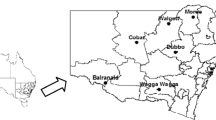Abstract
In undulating or sloping land, water distribution in soil has a major influence on crop yield through stresses on vegetation. It is difficult to predict the impacts, however, so a crop model is required to simulate topography-related horizontal redistribution of summer precipitation and its effect on yield. This study uses a potato model (POMOD), operating with the concept of meteorologically possible yield (MPY). It was supplemented to assess precipitation redistribution by runoff on a sloping surface. Slope incline, soil moisture and rainfall intensity were environmental parameters, with rainfall intensities replaced empirically with more convenient daily rainfall sums. Differences in the water balance, as compared to a non-sloping level surface, were computed for three different parts of a notional slope 3°. Modelled differences from long-term meteorological data allowed computation of comparative long-term series of MPY in two climatologically different localities in Estonia. These were the generally moister Tallinn and the frequently dry Kuressaare regions. The locations responded differently, but there was a significant influence in both of slope on potato yield. In the frequently dry Kuressaare, yield was limited by water deficiency, as was characterized by the change in MPY through slope. However, the moister Tallinn had the worst growing conditions at the foothill due to excess water. Tallinn had the greatest topography-related differences, leading to the conclusion that excess water causes more loss in potato yield than drought in Estonia. Events of extreme rainfall drive these losses.
Similar content being viewed by others
References
BACC Authors Team. 2008. Assessment of Climate Change for the Balitic Sea Basin. Regional Climate Studies. Springer, Berlin, 473 p.
Benoit G.R. & Grant W.J. 1985. Excess and deficient water stress effects on 30 years of Aroostok county potato yields. Am. Potato J. 62: 49–55.
Boyer J.S. 1982. Plant productivity and environment. Science 218: 443–448.
Epstein E. & Grant W.J. 1973. Water stress relations of the potato plant under field conditions. Agron. J. 65: 400–404.
Holden N.M., Brereton A.J., Fealy R. & Sweeney J. 2003. Possible change in Irish climate and its impact on barley and potato yields. Agric. Forest Met. 116: 181–196.
Kadaja J. & Tooming H. 2004. Potato production model based on principle of maximum plant productivity. Agric. For. Meteorol. 127: 17–33.
Kadaja J. 2004. Water sub-model of a dynamic agro-ecosystem model and empirical equation for evapotranspiration, pp. 184–185. In: Isemer H.-J. (ed.), Fourth Study Conference on BALTEX. Conference Proceedings.
Kadaja J. 2006. Reaction of potato yield to possible climate change in Estonia, pp 297–298. In: Fotyma M. & Kaminska B. (eds.), IX ESA Congress. Book of proceedings. Part I. Bibliotheca Fragmenta Agronomica 11. Pulawy-Warszawa.
Keevallik S. 1998. Climate change scenarios for Estonia, pp. 1–6. In: Kallaste T. & Kuldna P. (eds), Climate changes studies in Estonia, SEI.
Kirkham D. 1973. Soil physics and soil fertility. Bulletin des Researches Agronomiques de Gembloux Faculté des Sciences Agronomiques de l’état. 8: 60–88.
Porporato A., Laio F., Ridolfi L., Caylor K.K. & Rodriguez-Iturbe I. 2003. Soil moisture and plant stress dynamics along the Kalahari precipitation gradient. J. Geophys. Res. 108(D3): 4127–4134.
Ridolfi L., D’Odorico P., Porporato A. & Rodriguez-Iturbe I. 2000. Impact of climate variability on the vegetation water stress. J Geophys. Res. 105(D14): 18013–18025.
Robins J.S. & Domingo C.E. 1956. Potato yield and tuber shape as affected by severe soil moisture deficit and plant spacing. Agron. J. 48: 488–492.
Romanova E.N. 1966. Redistribution of the moisture on gentle slopes and at their foothills in a warm season, pp. 3–18. In: Goltsberg I.A. (ed.), Microclimatology, Hydrometeoizdat, Leningrad. (In Russian)
Romanova E.N. 1977. Microclimatic Variability of Main Elements of Climate. Hydrometeoizdat, Leningrad, 288 pp. (In Russian)
Saue T. & Kadaja J. 2009. Simulated crop yield — an indicator of climate variability. Bor. Env. Res. 14: 132–142.
Shaw B.T. 1952. Soil Physical Conditions and Plant Growth. Academic Press: New York.
Srinivasan G., Robock A., Entin J.K., Luo L., Vinnikov K.Y. & Viterbo P. 2000. Soil moisture simulations in revised AMIP models. J. Geophys. Res. 105(D21): 26635–26644.
Tooming H. 1967. Mathematical model of plant photosynthesis considering adaptation. Photosynthetica 1: 233–240.
Tooming H. 1970. Mathematical description of net photosynthesis and adaptation processes in the photosynthetic apparatus of plant communities, pp. 103–114. In: Setlik I. (ed.), Prediction and Measurement of Photosynthetic Productivity. Pudoc, Wageningen.
Tooming H. 1988. Principle of maximum plant productivity, pp. 129–138. In: Kull K. & Tiivel T. (eds), Lectures in Theoretical Biology. Valgus, Tallinn.
Tooming H. 1993. Evaluation of agrometeorological resources based on the potential productivity crops. J. Agric. Met. 48: 501–507.
Tooming H. 1998. Climate change and estimation of ecologically founded yields, pp. 141–152. In: Kallaste T. & Kuldna P. (eds), Climate Change Studies in Estonia. Ministry of Environment of the Republic of Estonia, SEI, Tallinn.
van Loon C.D. 1981. The effect of water stress on potato growth, development, and yield. Am. Potato J. 58: 51–69.
Wolf J. 1999. Modelling climate change impacts at the state scale on soybean, pp. 217–237. In: Harrison P.A., Butterfield R.E. & Downing T.E. (eds), Climate Change, Climate Variability and Agriculture in Europe: an Integrated Assessment. Environmental Change Unit Research Report 21. University of Oxford, Oxford, UK.
Author information
Authors and Affiliations
Corresponding author
Rights and permissions
About this article
Cite this article
Saue, T., Kadaja, J. Modelling crop yield response to precipitation redistribution on slopes. Biologia 64, 502–506 (2009). https://doi.org/10.2478/s11756-009-0103-x
Received:
Accepted:
Published:
Issue Date:
DOI: https://doi.org/10.2478/s11756-009-0103-x




